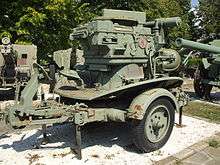Vickers Model 1931
The Vickers Model 1931 was a British anti-aircraft gun used during the Second World War. The design was rejected by the British and Vickers exported the gun worldwide during the 1930s. Romania bought a license for 100 in 1936, although hundred more were built during the war.[2] The second batch of 100 pieces was started in July 1941,[3] the production rate being of 5 pieces per month as of October 1942.[4] Denmark also bought a license. Belgium, the Netherlands, Lithuania, Turkey, Switzerland and China bought numbers of guns directly from Vickers. Finland bought a dozen to help reduce balance of payment problems with the British in 1936. The Finnish guns were chambered in their standard 76.2 mm (3 in) caliber.[5] Those weapons captured after the German conquest of Europe were taken into Wehrmacht service as the 7.5 cm Flak M 35(h) or 7.5 cm Flak M 35(d). Similarly the Soviet Union used those guns it captured from Lithuania. Supposedly it saw limited British service with Home Defense "barrage units" 1940—43.[6]
| Vickers Model 1931 | |
|---|---|
75mm Vickers antiaircraft gun model 1936/39 displayed in "King Ferdinand" National Military Museum, Bucharest | |
| Type | Anti-aircraft gun |
| Place of origin | United Kingdom |
| Service history | |
| In service | 1937–1950? |
| Used by | See users section |
| Wars | World War II |
| Production history | |
| Designer | Vickers |
| Manufacturer | Vickers Reșița |
| Produced | 1931–39? |
| Specifications | |
| Mass | 2,825 kg (6,228 lb) |
| Barrel length | 3.225 m (10 ft 7 in) L/43 |
| Shell | 75 x 495mm R[1] |
| Shell weight | 6.5 kg (14 lb 5 oz) (HE) |
| Caliber | 75 mm (3 in) |
| Carriage | Cruciform |
| Elevation | 0° to +90° |
| Traverse | 360° |
| Rate of fire | 12 rpm |
| Muzzle velocity | 750 m/s (2,500 ft/s) |
| Effective firing range | 5 km (3.1 mi) slant range |
| Maximum firing range | 10 km (33,000 ft) ceiling |

The cruciform carriage had two pneumatic or solid rubber wheels that were removable. Two legs locked together for transport and the barrel was secured to them. The other two legs folded in half and were elevated almost vertically into the air (see the Romanian reference to see exactly how it looked).[7]
Users
Notes
- "75-77 MM CALIBRE CARTRIDGES". www.quarryhs.co.uk. Retrieved 12 September 2017.
- Axworthy, p. 30
- Axworthy, p. 30
- Axworthy, p. 75
- "ANTIAIRCRAFT GUNS PART 3: Heavy Guns". 23 September 2007. Retrieved 22 May 2009.
- Gander and Chamberlain, p. 163
- "75mm Vickers antiaircraft gun model 1936/39". Retrieved 22 May 2009.
References
- Axworthy, Mark; Scafes, Cornel; Craciunoiu, Cristian (1995). Third Axis, Fourth Ally: Romanian Armed Forces in the European War, 1941-1945. London: Arms and Armour. ISBN 1-85409-267-7.
- Gander, Terry; Chamberlain, Peter (1979). Weapons of the Third Reich: An Encyclopedic Survey of All Small Arms, Artillery and Special Weapons of the German Land Forces 1939-1945. New York: Doubleday. ISBN 0-385-15090-3.